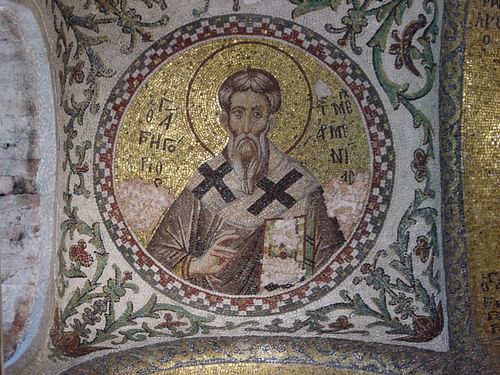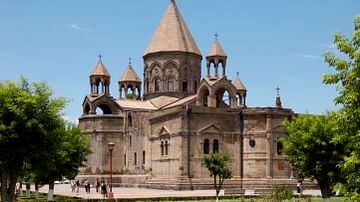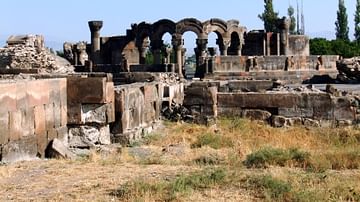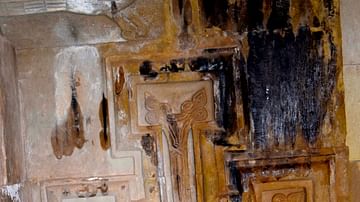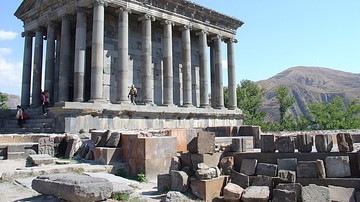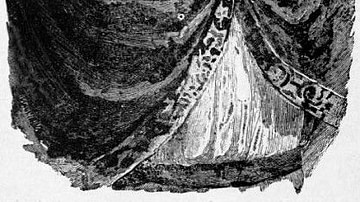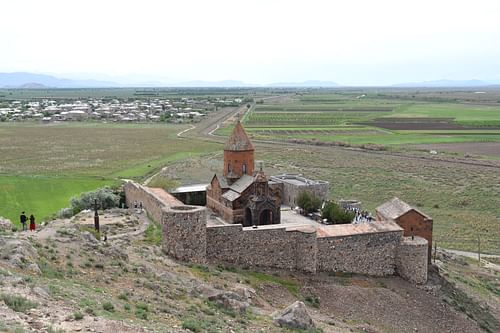
Khor Virap is a monastery located in Armenia that was first established in 642 CE. Its name is derived from "virap nerk'in," which means "deep dungeon" in Armenian. Khor Virap is one of the most sacred and visited sites in Armenia primarily due to the legend of Saint Gregory the Illuminator who was imprisoned for 13 years in Khor Virap's dungeon before succeeding in the conversion of King Tiridates (Trdat) the Great to Christianity in the first decades of the 4th century CE. During the Middle Ages, Khor Virap was a center of education and learning, and despite a colossal earthquake in 1679 CE, it remains a site of pilgrimage and immense cultural interest to Armenians today.
The monastery consists of the St. Gevorg Chapel, the St. Astvatsatsin Chapel, a large courtyard, and fortified walls. Khor Virap is set upon a chain of hills in the Ararat Plain in Armenia's Ararat Province. The monastery affords spectacular views of Mount Ararat and the present-day Turkish border, which is delineated by the Aras River. Khor Virap is additionally within sight of the ruins of the ancient Armenian capital of Artashat, 16 km (10 mi) from the ancient city of Dvin, and 43 km (27 mi) of the modern Armenian capital, Yerevan.
Saint Gregory the Illuminator & Khor Virap
Khor Virap's importance in Armenian folklore, history, and Christianity is tied to the figure of Saint Gregory the Illuminator (c. 239 - c. 330 CE). Much of what we know about him comes from a biography dating to c. 460 CE and the more or less contemporary History of the Armenians by the writer and historian Agathangelos.
Gregory (or originally Grigor Lusavorich) was born in Roman Cappadocia and belonged to a noble family with strong ties to the Sasanian Empire of ancient Persia (224-651 CE). Raised as a Christian and educated in Greek, Gregory rejected paganism in Armenia, refusing to participate in rituals and ceremonial court functions that offended his Christian sensibilities. Tiridates the Great (Trdat III or IV), in an act of anger, tortured and imprisoned Gregory in a dungeon in Khor Virap. Gregory languished in prison for 13 years, surviving thanks to the generosity of local peasants - particularly poor Christian women - who provided him with food and clothes.
Serendipitously, Gregory was rescued by Tiridates' sister Princess Khosrovidukht. Curiously, she is also well-known in Armenia for having saved the Temple of Garni from destruction. In a dream, she saw that Gregory was the only man who could save her brother from madness and other debilitating ailments. Legend has it that Gregory was released from Khor Virap, and he shortly thereafter cured the king from his unusual symptoms. Gregory is widely credited with converting Tiridates the Great to Christianity, officially establishing the Armenian Apostolic Church, and spreading the Christian religion throughout Armenia and the Caucasus. Saint Gregory the Illuminator was also the first bishop of the Armenian church, and he is thus the patron saint of Armenia.
History & Architecture
A pagan temple was once located on the site that is now occupied by Khor Virap in ancient times. Archaeologists believe that it was dedicated to Anahit, the Armenian goddess of fertility, healing, and wisdom, and several artifacts unearthed from the former temple are now housed in the British Museum. The area around Khor Virap and the ancient city of Artashat was the locus of resistance against the Persian Sassanian Empire's efforts to force Zoroastrianism upon the Armenian populace during the rebellion of Vartan (or Vardan) Mamikonian (c. 387-451 CE) in the 450s CE.
On the orders of Catholicos Nerses III “the Builder” (r. 641-661 CE), a Christian chapel, the St. Gevorg Chapel, was built at Khor Virap around the year 642 CE as part of an ambitious building program to consolidate Nerses' power and influence in the region as the Muslim Arab armies began their invasions of Armenia. Nerses III had been elected as the Catholicos of the Armenian Apostolic Church around the year 640 CE just as the Arabs arrived in Armenia, and during this era, the Armenian Catholicos - the head of the Armenian Apostolic Church - held both temporal and spiritual power over the Armenian people. Nerses III, therefore, exercised and wielded considerable political might. It should be noted that Nerses III was additionally responsible for the construction of the Zvartnots Cathedral - this structure lies 47 km (29 mi) northwest of Khor Virap - which was built at the same time as the St. Gevorg Chapel.
Nerses III wished to honor the memory of Saint Gregory the Illuminator, as he was a key figure in Armenian folklore and history, and tie the name of the saint to his own through the construction and patronage of the chapel. According to the medieval histories, Nerses III was even buried at Khor Virap in close proximity to the sacred relics of Saint Gregory the Illuminator. The supposed pit where Saint Gregory the Illuminator was incarcerated still exists, located some 60 m (200 ft) below the St. Gevorg Chapel, and is accessible by a metal ladder. The room is circular but only about 4 m (14 ft) wide. Unlike most Armenian churches, which are positioned on an east-west axis, the St. Gevorg Chapel is has a northwest-southeast orientation, just like the pagan Temple of Garni. The St. Gevorg Chapel has been rebuilt over the centuries due to constant invasion and countless earthquakes.
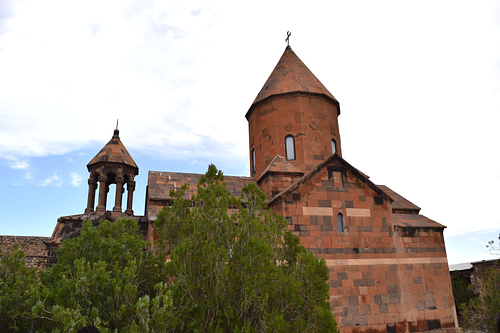
In 1662 CE, a larger chapel, the St. Astvatsatsin Chapel, was constructed during the period that Armenia was under the control of the Persian Safavid Empire (1501-1736 CE). An earlier church had existed on the same spot, but it was destroyed during one the invasions of Armenia led by Timur (r. 1370-1405 CE) in the late 14th century CE. That church was in turn built upon the ruins of the pagan temple dedicated to Anahit as noted above. St. Astvatsatsin distinguishes itself from other Armenian churches by virtue of its elongated structural design: it is composed of a domed long hall with two annexes on both sides of the apse. This stands in direct contrast to most medieval Armenian churches, which have a more centralized design of a domed cruciform and four corner annexes. Restored in 1939, 1949, 1957, and 2000-2001 CE, St. Astvatsatsin remains a functioning church and thus receives many worshippers every year.
This article was made possible with generous support from the National Association for Armenian Studies and Research and the Knights of Vartan Fund for Armenian Studies.
